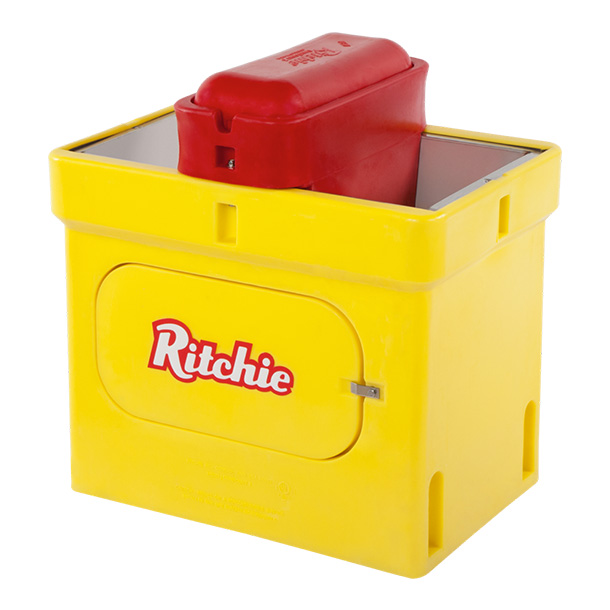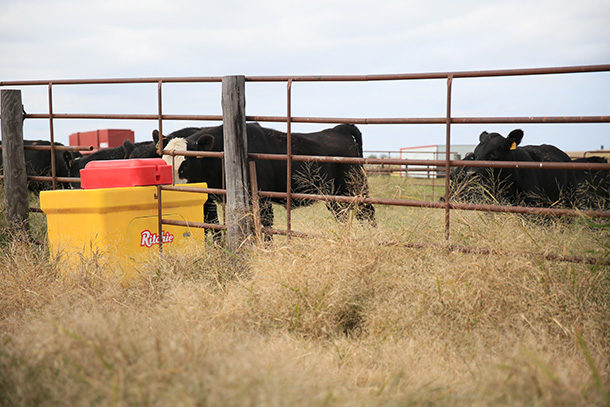1921 was a monumental year for the U.S. dairy industry. In addition to passing the Packers and Stockyards Act of 1921, Congress also established standards for food weight and measurement in the District of Columbia. According to the law, milk or cream products could only be sold in authorized units, which included the gallon, pint, and half-pint. The sale of ice cream in non-standard sizes was reportedly the largest criminal activity in Washington, D.C. from 1921 to 1963 according to the archives of the United States House of Representatives.
1921 saw the formation of the Land O’Lakes agricultural cooperative in St. Paul, Minnesota. Land O’Lakes is the third largest cooperative in the United States and had $13.9 billion in revenue for 2019. The cooperative handles over 12 billion pounds of milk annually and is the largest branded butter producer in the United States.
The innovative Surge brand Belly Milker debuted in 1921. This milking machine hung by a strap over the cow’s back which kept the machine closer to the udder. The pulsing movement of the machine mimicked the motions of a calf suckling which was gentler and more effective than earlier machines that relied on a continuous vacuum.
In the heartland of Iowa, Thomas Ritchie, an Oskaloosa native, was busy inventing a better way to water livestock. In 1921, Ritchie patented the first automatic waterer valve that solved many of the headaches that farmers faced in getting water to their livestock. His automatic float-controlled watering equipment was connected to underground running water and heated with a kerosene lamp to keep the water flowing during the bitter cold. Farmers liked the labor-saving qualities of Ritchie’s patented waterer, and a new business was born.
Livestock producers from Iowa and several other states were soon installing Ritchie’s waterers. In a written testimonial dated January 24, 1925, Walter L. French from Stratton, Nebraska noted: “We bought a hog waterer from you at the Nebraska State Fair last fall. It sure was a dandy. It has been 26 degrees below zero and have had warm water for our hogs at all times.”
In 1929 Ritchie incorporated and moved to an old machine shed in Marshalltown, Iowa. Part of the manufacturing also took place in a small machine shed in Conrad, Iowa until 1943. That year, blacksmith C.D. Wilson purchased Ritchie, moved the business to Conrad, Iowa and operated the business out of a small blacksmith shop. Shortly after the move, automatic electric heat was introduced to the watering equipment helping to establish Ritchie as the leader in the industry.
After his father’s death in 1979, C. D. Wilson Jr. took the reins of the business. He expanded its market and the technology of the product. To meet demands, the company had gone from making six models to more than 40, giving it the distinction of being the largest manufacturer and distributor of the most complete line of animal and livestock watering equipment in North America. In January of 2004, Ritchie Industries became employee owned.
“Today Ritchie Industries engineers, designs and manufacturers waterers to serve every type of livestock – from an individual horse to 500 beef or 250 dairy cattle,” said Robert Amundson, President and CEO of Ritchie Industries. “All of our waterers are engineered to meet Grade A dairy recommendations. Troughs can be emptied, cleaned and refilled in a fraction of the time it takes other waterers just to empty. Just like other technological advancements such as robotic milkers and RFID tags have helped improve the efficiency of dairy operations, we are constantly striving to improve your bottom line. If you haven’t thought about upgrading your watering systems, now is the time to look at what new innovations are on the market. Our WaterMaster series require 75% less energy in the winter than concrete units and they won’t pit or cause cleaning problems. Our OmniMaster series is the latest in large herd innovation with a newly designed high capacity drain to maintain the cleanliness of the drinking environment. These units have a stainless-steel trough with a unique wrap around edge that has been specifically designed to protect against animal injury. The unit is thermostatically controlled with a fast refill valve to give your dairy cows clean, fresh water in the harshest of climates.”
2021 and beyond – Ritchie Industries and the U.S. dairy industry continue to innovate
According to FoodBev Media in 2020, there are some exciting new innovations that are emerging that may have a lasting impact on the dairy industry. These include: supercooling technology that allows fresh dairy products to travel long distances by ship which can create new global growth opportunities; early mastitis detection technology that uses machine learning and multi-spectral imaging to detect mastitis days before there are any physical symptoms in the cow; and blockchain technology that tracks and creates a permanent record of food safety diagnostics and animal genomics creating a high level of transparency throughout the entire production cycle.
Sustainability and environmental concerns continue to be a hot topic for dairy producers and consumers alike. Frank Mitloehner, PhD, a professor and air quality extension specialist in the Department of Animal Science at the University of California-Davis, has studied the progress and successes of U.S. dairy in this arena.
In 1944, the U.S. had 25 million dairy cows. In 2019, there were around 9 million cows. Innovative practices related to cow comfort, improved feed and genetics, and modern barn design, have helped dairy farmers produce 60 percent more milk in 2019 than in 1944.
Research conducted in 2007 found the dairy industry accomplished this with 65 percent less water, 90 percent less land, a 63 percent smaller carbon footprint and 76 percent less manure than in 1944. An update of this research revealed more good news. Producing a gallon of milk in 2017 involved 30 percent less water, 21 percent less land, a 19 percent smaller carbon footprint and 20 percent less manure than it did in 2007.
“We have reduced the carbon footprint of a glass of milk by two-thirds over this period of time,” Mitloehner said. “If you would have asked scientists 50 years ago, they would have told you there’s no way we can further improve efficiencies. Even 10 years ago, they would have told you the same thing. Guess what? They were all wrong. But one thing I can tell you is we will have further reductions of emissions and we will have further improvements in efficiencies. There’s no question about that.”

Designed with animal safety in mind, the Omni 3 features smooth rounded edges and a fully insulated casing for energy efficiency. Photo courtesy of Ritchie Industries.
For 100 years Ritchie Industries has been a leader in providing fresh, clean water for life in an efficient manner for dairy operations around the world. Ritchie continues to innovate their products to keep pace with the rapid changes and challenges facing production agriculture. This commitment to always be better has led to greater gains in energy use conservation and the Ritchie product line qualifies for utility incentives offered through participating electric cooperatives throughout the U.S.
“Installing a reliable, clean water source is one of the key steps to becoming a sustainable and profitable operation,” said Amundson. “We have supported American dairy farmers with our American-made products for 100 years and we look forward to another 100 years of innovation and progress.”
For more information, visit Ritchie Industries online.





